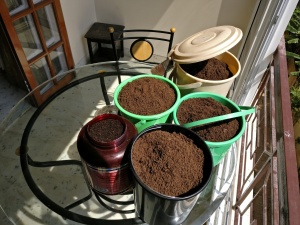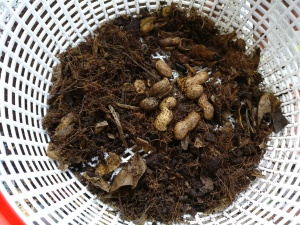The desire for gold is not for gold. It is for the means of freedom and benefit. ~ Ralph Waldo Emerson.
Being a woman, as I am expected to go ga-ga over gold, I chose a different colored one instead. Black gold. No, I don’t have any slick oil deals, but I stick to good old home-made compost. Rana and I were introduced into the world of solid waste

3 tier Kambha (small)
management when we worked with the dedicated teams of Citizen Matters and 2bin1bag. We haven’t stopped talking trash since then. One of the many things we learned in this journey was to keep our wet waste with us. Since we were planning to move homes, I thought of using a guinea pig – my father. He went in for a home composter, the smallest earthen Kambha set from Daily Dump.
It has been fairly smooth sailing for him. He proudly says that not even a single curry leaf has left his home. The initial bag of remix powder (cocopeat) lasted him for nearly 12 months. In terms of investment, it has been quite minimal, even if you consider INR 140 for a remix bag! This is a system of aerobic composting, where the

Curry leaves and lemons harvested from my father’s garden
pots have holes in them, allowing for movement of air. Once you “prepare” a pot – that is, add a layer of newspaper, dry leaves and a few handfuls of remix powder or mature compost- all you need to do is add the wet waste and layer it with remix powder. No stirring required. You can do this ritual every day, or whenever you gather about a few handfuls of wet waste. He keeps his composting unit indoors, so that he doesn’t have to take extra precaution during rains. There is decent ventilation at home, and hence, there is no smell near the Kambha.
While he was midway into this journey, we shifted homes. We were looking for a unit for a four-member household and I thought of going in for

Notice the holes on the sides
two 55 ltr drums from Shudh Labh. This comes with a bottom tray, and the process is similar to Daily Dump’s Kambha, as this is also aerobic. One layer of “greens” (the wet waste) needs to be topped up with a layer of “browns” (microbial cocopeat, in this case). You might ask me, “Hey, but these drums are plastic!” Yes, of course, but this isn’t a single-use disposable. Just imagine, after every use, if I begin to throw these drums!
 This was our first harvest of black gold, the mature compost – its fragrance reminding us of the wet earth after the first rains. We sieved it, because we then
This was our first harvest of black gold, the mature compost – its fragrance reminding us of the wet earth after the first rains. We sieved it, because we then began to gift our compost. My mum-in-law says that in her days, she would prepare sweets, or sambar powder, or a special dish to gift her loved ones. Times
began to gift our compost. My mum-in-law says that in her days, she would prepare sweets, or sambar powder, or a special dish to gift her loved ones. Times

Half-done compost tells tales, of who sneaked in groundnuts while nobody was watching
are a-changing, and she now collects idli batter covers to gift compost 😀 The usual practice in any Indian home is to take guests around and show off our place. In our family, we show off our garbage. I mean, we show them all the wet waste that has been sitting around for months.

Mature compost, sieved
But this wasn’t without hiccups. My dad was layering wet waste with compost and saving

My mum-in-law cutting peels, to hasten the composting process.
on money. “Oh, you think I can’t do the same?” said the thought bubble in my head. So, at home, I advised everyone to use a mix of microbial cocopeat and mature compost for the layer of browns. They say, “penny wise pound foolish”, and for a good reason. After one of the drums filled up and we parked it aside for it to

White fungus on top, a sign of healthy compost
mature, it began giving out leachate in the tray below. The tray is there for that reason, but that didn’t necessarily mean we had to ensure it was used! What followed next was an exercise of drying out the half-done compost, adding a lot of extra microbial cocopeat to hold the moisture, and splitting this into two drums. In the process of trying to beat my father’s low spending, I ended up spending more money and time in fixing problems. Of course, we were rich with experience. I now gift free advice, tips and tricks along with home-made compost.
The time had come, again. Do we try a different method? I was still hell bent on cutting

No holes. What are friends for, if you don’t exchange composting bins? 😉
down on cost, you see. I was discussing these with my friends, gathering tips. Just then, my friend, Anjana, said she had moved to leave-it pots by Daily Dump. She offered to let me borrow her Trustbin bins. Now, this is a system of anaerobic composting, where the container doesn’t have any holes. You prepare the bin by adding a handful of jaggery, and place a tray on top of it. Add your wet waste, press it down to remove any extra air, and layer with two tablespoons of bran for every inch of wet waste. After a bin is full, keep it aside for a minimum of two weeks, where the wet waste ferments and gets “pickled”. This, is the first stage of the bokashi method. If you open the bin, you will get a strong, vinegar-like smell. You might take a bit of time getting used to it, but this is probably a point to be wary of, in this method.

Palak in our kitchen garden
In the second stage, you go back to aerobic method. Take out a layer of fermented pickle and add it to the aerobic container. Layer it with an equal quantity of already mature compost. I had a lot of the latter, anyway. So right now, I am using a combination of Trustbin containers for the first stage, with Shudh Labh drums for the second stage. Yup, I layer with mature compost and even then, the

Mum-in-laws green thumb, aided by home-made gobbara
pickle turned to black gold in just about two weeks! That was real quick 😀 I tried the second stage in a Daily Dump leave-it pot as well – the earthen pot absorbed not just the moisture, but also the rather strong smell of the fermented pickle. Don’t try this combination, though, of using Daily Dump along with Bokashi.
Oh, you must be wondering about the jaggery. It has a role to play. The anaerobic bin begins to give out a leachate – a liquid which gets generated from the wet waste, in combination with the bran. This liquid is highly nutritious and concentrated. You can harvest this “brew” once every few days. Mix it in a proportion of 1:30 and water your plants with it. Or, use it undiluted to de-clog your drains. I am testing out the brew in our kitchen garden and my father’s garden. Oh yes, our tomato plant is growing way out of control, and I don’t know if we should blame the brew 😉
Our composting journey has been fulfilling, and I must say I am addicted to it. I am proud to say that we keep all our wet waste with us. I prefer the daily dump earthen pots to the plastic drums, because by nature, the earthen pots absorb more moisture. In fact, sometimes they absorb so much moisture that your compost could be dry! In terms of

Lovely, beautiful white fungus in the bokashi unit.
cost and the fact that I am not always around to do firefighting of drum leakages, I would recommend either the Kambha or smaller drums (if you prefer plastic). The khamba is prone to breakage if you walk clumsily and knock it down. At the moment, I am enjoying making the brew and seeing the compost maturing so quickly. I must also add that after we shifted to bokashi, we have not seen any maggots in our compost. Note that maggots are absolutely harmless to humans, and are great for your compost.
If you are planning to get started on your composting journey, don’t think twice. Start right away – check SwachaGraha for more info 🙂 Please feel to ask questions, or share your tips and tricks in the comments section.
Sugandhi





Leave a comment